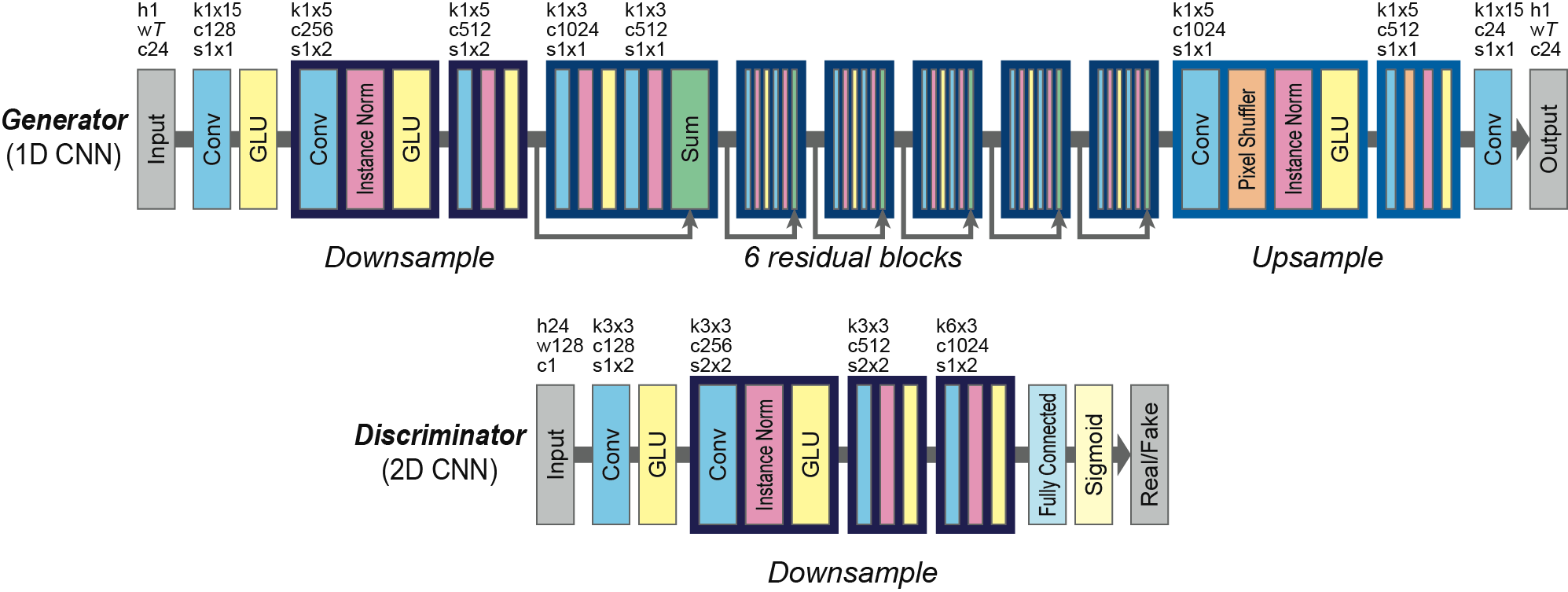pritishyuvraj / Voice Conversion Gan
Projects that are alternatives of or similar to Voice Conversion Gan
Voice-Conversion-GAN
Voice Conversion using Cycle GAN's (PyTorch Implementation). Architecture of the Cycle GAN is as follows:
Dependencies
- Python 3.5
- Numpy 1.14
- PyTorch 0.4.1
- ProgressBar2 3.37.1
- LibROSA 0.6
- FFmpeg 4.0
- PyWorld
Usage
Download Dataset
Download and unzip VCC2016 dataset to designated directories.
$ python download.py --help
usage: download.py [-h] [--download_dir DOWNLOAD_DIR] [--data_dir DATA_DIR]
[--datasets DATASETS]
optional arguments:
-h, --help show this help message and exit
--download_dir DOWNLOAD_DIR
Download directory for zipped data
--data_dir DATA_DIR Data directory for unzipped data
--datasets DATASETS Datasets available: vcc2016
For example, to download the datasets to download directory and extract to data directory:
$ python download.py --download_dir ./download --data_dir ./data --datasets vcc2016
Preprocessing for Training
Preprocess voice data and stores it in numpy format in ../cache folder
$ python prepocess_training.py --help
Usage: preprocess_training.py [-h] [--train_A_dir TRAIN_A_DIR]
[--train_B_dir TRAIN_B_DIR]
[--cache_folder CACHE_FOLDER]
Prepare data for training Cycle GAN using PyTorch
optional arguments:
-h, --help show this help message and exit
--train_A_dir TRAIN_A_DIR
Directory for source voice sample
--train_B_dir TRAIN_B_DIR
Directory for target voice sample
--cache_folder CACHE_FOLDER
Store preprocessed data in cache folders
For example, to train CycleGAN model for voice Conversion between SF1 and TM1:
$ python prepocess_training.py --train_A_dir ../data/vcc2016_training/SF1
--train_B_dir ../data/vcc2016_training/TM1
--cache_folder ../cache/
Train Model
$python train.py --help
usage: train.py [-h] [--logf0s_normalization LOGF0S_NORMALIZATION]
[--mcep_normalization MCEP_NORMALIZATION]
[--coded_sps_A_norm CODED_SPS_A_NORM]
[--coded_sps_B_norm CODED_SPS_B_NORM]
[--model_checkpoint MODEL_CHECKPOINT]
[--resume_training_at RESUME_TRAINING_AT]
[--validation_A_dir VALIDATION_A_DIR]
[--output_A_dir OUTPUT_A_DIR]
[--validation_B_dir VALIDATION_B_DIR]
[--output_B_dir OUTPUT_B_DIR]
Train CycleGAN using source dataset and target dataset
optional arguments:
-h, --help show this help message and exit
--logf0s_normalization LOGF0S_NORMALIZATION
Cached location for log f0s normalized
--mcep_normalization MCEP_NORMALIZATION
Cached location for mcep normalization
--coded_sps_A_norm CODED_SPS_A_NORM
mcep norm for data A
--coded_sps_B_norm CODED_SPS_B_NORM
mcep norm for data B
--model_checkpoint MODEL_CHECKPOINT
location where you want to save the odel
--resume_training_at RESUME_TRAINING_AT
Location of the pre-trained model to resume training
--validation_A_dir VALIDATION_A_DIR
validation set for sound source A
--output_A_dir OUTPUT_A_DIR
output for converted Sound Source A
--validation_B_dir VALIDATION_B_DIR
Validation set for sound source B
--output_B_dir OUTPUT_B_DIR
Output for converted sound Source B
For example, to train CycleGAN model for voice conversion between SF1 and TF2:
$python train.py --logf0s_normalization ../cache/logf0s_normalization.npz --mcep_normalization ../cache/mcep_normalization.npz --coded_sps_A_norm coded_sps_A_norm --coded_sps_B_norm coded_sps_B_norm --resume_training_at ../cache/model_checkpoint/_CycleGAN_CheckPoint --validation_A_dir ../data/vcc2016_training/evaluation_all/SF1/ --output_A_dir ../data/vcc2016_training/converted_sound/SF1 --validation_B_dir ../data/vcc2016_training/evaluation_all/TF2/ --output_B_dir ../data/vcc2016_training/converted_sound/TF2/
Reference
- Takuhiro Kaneko, Hirokazu Kameoka. Parallel-Data-Free Voice Conversion Using Cycle-Consistent Adversarial Networks. 2017. (Voice Conversion CycleGAN)
- TensorFLow Implementation
To-Do List
- [x] CPU compatible
- [ ] Sample Outputs
- [ ] Evaluation Metrics
Useful Tutorials
PyTorch Tutorial: https://github.com/yunjey/pytorch-tutorial
Gaussian Mixture Model Voice Conversion: https://r9y9.github.io/nnmnkwii/latest/nnmnkwii_gallery/notebooks/vc/01-GMM%20voice%20conversion%20(en).html
CycleGAN - VC: http://www.kecl.ntt.co.jp/people/kaneko.takuhiro/projects/cyclegan-vc/
Voice Conversion using Variational Auto-Encoder: https://github.com/JeremyCCHsu/vae-npvc

